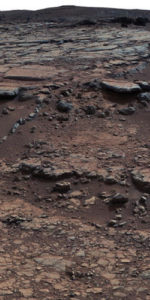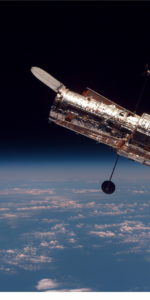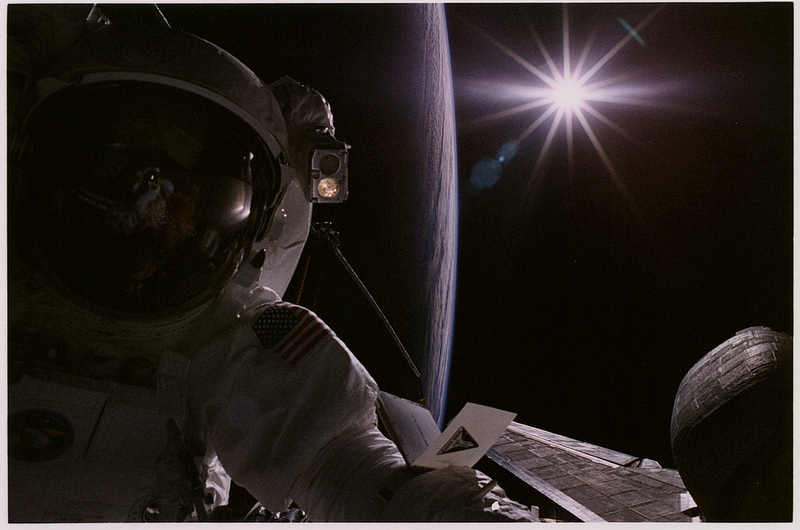
Twenty years have now passed since a seven-man rocketed into the night to begin the second servicing mission to the $1.5 billion Hubble Space Telescope (HST). Coming on the heels of the ambitious STS-61 shuttle flight in December 1993—during which astronauts had corrected the telescope’s aberrated vision with corrective optics—STS-82 in February 1997 would transform Hubble yet again from a repaired observatory to a brand-new one, fit for the 21st century. “I would think the only other instrument that would rival it in historical value,” said STS-82 Mission Specialist Steve Hawley, one of only seven humans to have visited Hubble twice in orbit, “would be Galileo’s original telescope.”
Launched aboard shuttle Discovery on 11 February 1997, the $260 million STS-82 flight was originally intended to support four periods of Extravehicular Activity (EVA) by two teams of spacewalkers: Payload Commander Mark Lee and Mission Specialists Steve Smith, Greg Harbaugh and Joe Tanner. These four men were announced by NASA in May 1995 and both Lee—then-chief of the Astronaut Office’s EVA Branch—and Harbaugh had prior spacewalking experience, with Smith and Tanner preparing for their first excursions into vacuum. “Mark had worked Hubble tasks, back before we deployed Hubble in the first place,” recalled Hawley in a NASA interview.
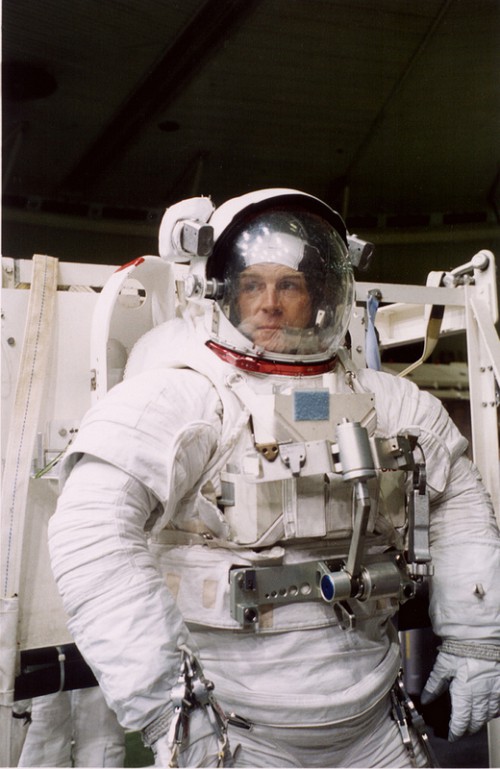
The four EVAs would install the Space Telescope Imaging Spectrograph (STIS) in place of the aging Goddard High Resolution Spectrograph (GHRS) and also remove the Faint Object Spectrograph (FOS) and replace it with the Near-Infrared Camera and Multi-Object Spectrometer (NICMOS). These two new instruments carried enormous potential for Hubble’s future. STIS would perform two-dimensional spectroscopic mapping of planets, stellar nebulae and entire galaxies and its high degree of sensitivity was expected to resolve fine details in star formation, identify supermassive black holes and investigate matter distribution in the Universe. Meanwhile NICMOS acted as a combined spectrometer, coronagraph and polarimeter to provide Hubble with near-infrared capability. In order to attain the requisite low operating temperatures, NICMOS included a dewar of solid nitrogen and carbon dioxide, which would cool it for up to five years.
Early planning for STS-82 foresaw the priority installation of STIS and NICMOS, each of which was about the size of a telephone booth, by Lee and Smith during EVA-1. Next day, Harbaugh and Tanner would venture outside to install a Fine Guidance Sensor (FGS) to replace one of three existing devices, which was showing signs of mechanical wear. Next, the duo would install a new Engineering/Science Tape Recorder (ESTR), then an Optics Control Electronics Enhancement Kit (OCEK).
During EVA-3, Lee and Smith would replace a Reaction Wheel Assembly (RWA) and one of four Data Interface Units (DIUs). They would also remove a second ESTR and install a Solid State Recorder (SSR) to support the high data-rates of STIS and NICMOS. Finally, on EVA-4, Harbaugh and Tanner would replace one of two European-built Solar Array Drive Electronics (SADE) and fit protective covers over key hardware components to replace material which had degraded in the harsh atomic oxygen environment of low-Earth orbit. In the aftermath of the mission, a standard Servicing Mission Orbital Verification (SMOV) of the enhancements and new hardware—lasting eight to ten weeks—would take place, before Hubble returned to full science operations.
By the beginning of 1996, with a little more than a year remaining before launch, the time came to assign the remainder of the STS-82 crew. Ken Bowersox, who had piloted the first Hubble servicing mission, was assigned as Commander. He would be joined by Pilot Scott “Doc” Horowitz and Mission Specialist Steve Hawley, who would operate the Canadian-built Remote Manipulator System (RMS) mechanical arm to retrieve and deploy Hubble and maneuver the spacewalkers and their tools.
Training required the crew to spend a great deal of time in the water tanks of the 40-foot-deep (12-meter) Neutral Buoyancy Simulator (NBS) at the Marshall Space Flight Center (MSFC) in Huntsville, Ala., and the 25-feet-deep (7.6-meter) Weightless Environment Training Facility (WET-F) at the Johnson Space Center (JSC) in Houston, Texas. The construction of a large Neutral Buoyancy Laboratory (NBL) had begun in April 1995 at JSC, primarily to support EVA preparations for ISS assembly tasks, and, according to Hawley, STS-82 was the final shuttle mission to use Marshall’s NBS. The much larger NBL was formally transferred to NASA ownership upon its completion in December 1996, just a few weeks before the launch of STS-82. “I didn’t get much time in the NBL,” Hawley admitted, “because we only had about a month before we launched.”
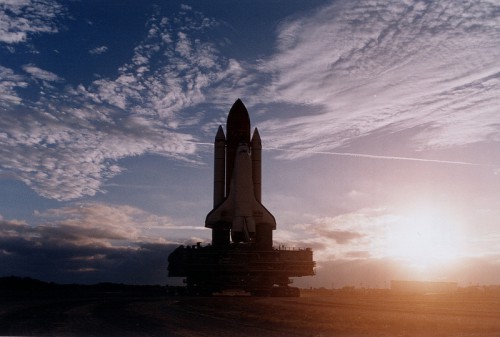
The training in the NBS, however, was highly realistic because the astronauts could operate in an “integrated” manner with the spacewalkers and the RMS. “You actually had the real space-suited crewmember on a real arm,” Hawley said. “It’s underwater, but you can actually maneuver him around. The experience was extremely valuable to learn the task that he had to do and the task that I had to do and learn how to communicate back and forth. In fact, we got to where you could run each EVA day pretty much end-to-end, as it would really work, with quite high fidelity.”
To enable the multitude of servicing tasks, the STS-82 crew carried numerous tools and aids with them into orbit, which included handrails and handholds, transfer equipment, protective covers, tethers, grapple and stowage fixtures, and foot restraints. A 17-inch (43-cm) titanium-aluminum Power Ratchet Tool was designed for tasks requiring controlled torque, speed or turns and could be used in cases where right-angle access to telescope components was required. The Multisetting Torque Limiter was used in conjunction with the power tools and hand tools which interfaced with bolts or latches and was designed to prevent damage caused by the application of torque, whilst NASA’s new Pistol Grip Tool fulfilled a key recommendation from the first Hubble servicing crew, who highlighted the need for a smaller, more efficient piece of equipment for very precise tasks.
All told, and when including spares of the tools and various connectors, adjustable extensions, and sockets, the STS-82 crew rose into orbit in February 1997 with more than 300 discrete pieces of equipment to service Hubble. Their efforts would transform the telescope from a 1970s-era spacecraft, with 1980s optics, into a vehicle for the 21st century with instrumentation which promised to revolutionize astronomy.
In spite of delays to several shuttle flights in 1996, the mission held firm to its target launch date of February 1997. Originally scheduled to launch on the 13th, it actually flew two days earlier, on the 11th. At first glance, this seemed surprising, in view of numerous minor issues in the weeks preceding the mission. During Discovery’s rollout to the pad in mid-January, whilst on the crawlerway, the stack was halted when a large, Y-shaped crack was identified on the deck plating of the Mobile Launch Platform (MLP). Despite its alarming appearance it was determined that the MLP’s integrity had not been compromised and the rollout continued.
Then, in the hours before liftoff, the loading of propellants into the External Tank met with delay, due to the need to assess the gaseous nitrogen purge system and monitor unusually high concentrations of trapped oxygen in the orbiter’s midbody and payload bay. With the launch window due to open at 3:56 a.m. EST on 11 February, at the opening of a 61-minute “window,” the precise time was adjusted slightly to 3:55:17 a.m. at T-9 minutes, based on a final computation of Hubble’s orbit. Exactly on time, to the very second, Discovery turned night into day across the Florida coast as she speared into one of the shuttle’s highest ever orbits, with an apogee of 356 miles (574 km) and a perigee of 295 miles (475 km). A few hours later, they were trailing their quarry by 3,560 miles (5,740 km), closing at a rate of about 350 miles (560 km) with each 90-minute orbit.
The second part of this article will appear tomorrow.
Want to keep up-to-date with all things space? Be sure to “Like” AmericaSpace on Facebook and follow us on Twitter: @AmericaSpace




